Beko RSSE 415 M 23 DW, RSSE415 M 23 DS, RSSE 415DS, RES41W, RES41S User manual [EN,FR,HR]
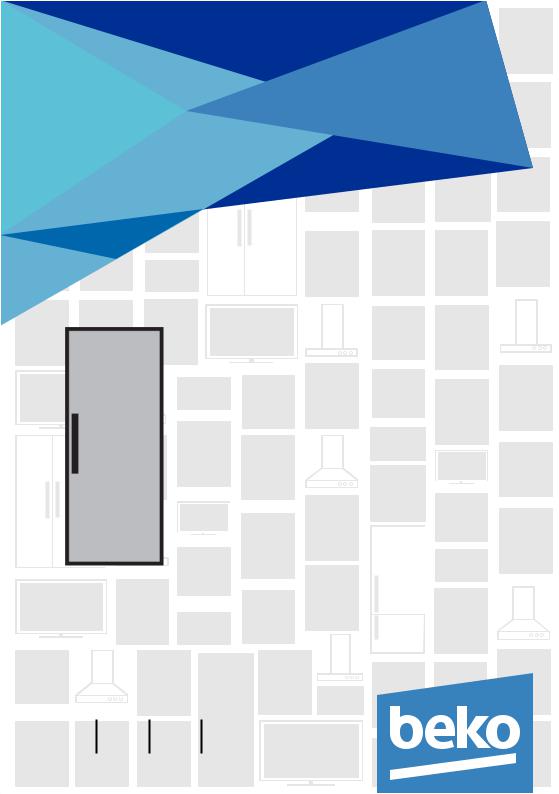
Refrigerator |
||
User manual |
||
|
|
Réfrigérateur |
|
|
Manuel d'utilisation |
|
|
Hladnjak |
|
|
Korisnički priručnik |
|
|
RSSE 415 M 23 DW |
|
|
RSSE415 M 23 DS |
|
|
RSSE 415DS |
|
|
RES41W |
|
|
RES41S |
EWWERQWEW |
|
|
EN |
FR |
HR |
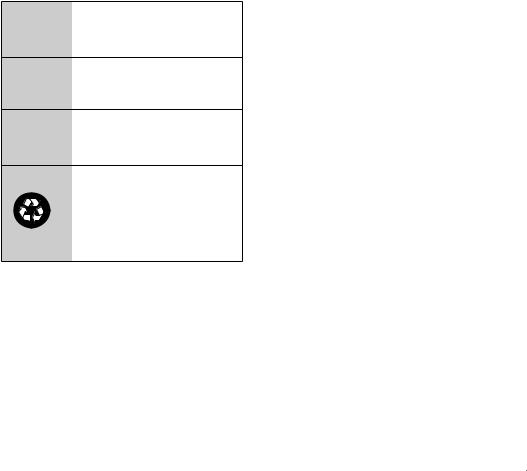
Please read this manual before using the product!
Dear Customer,
We'd like you to make the best use of our product, which has been manufactured in modern facilities with care and meticulous quality controls.
Thus, we advice you to read the entire user manual before you use the product. In case the product changes hands, do not forget to hand the guide to its new owner along with the product.
This guide will help you use the product quickly and safely.
•Please read the user guide carefully before installing and operating the product.
•Always observe the applicable safety instructions.
•Keep the user guide within easy reach for future use.
•Please read any other documents provided with the product.
Keep in mind that this user guide may apply to several product models. The guide clearly indicates any variations of different models.
C Important information and useful tips.
A Risk of life and property.
B Risk of electric shock.
The product’s packaging is made of recyclable materials, in accordance with the National Environment Legislation.

1 Safety and environment |
|
instructions |
4 |
General safety................................................ |
4 |
Intended use.................................................... |
7 |
Child safety....................................................... |
7 |
Compliance with WEEE Directive and |
|
Disposing of the Waste Product............. |
8 |
Compliance with RoHS Directive............ |
8 |
Package information.................................... |
8 |
2 Your refrigerator |
9 |
3 Installation |
10 |
Appropriate installation location.......... |
10 |
Adjusting the feet........................................ |
11 |
Electrical connection.................................. |
11 |
Changing the illumination lamp ............ |
11 |
Door Open Warning..................................... |
11 |
4 Preparation |
13 |
5 Using your freezer |
14 |
Cooling............................................................. |
15 |
Placing the food........................................... |
15 |
Defrosting of the appliance.................... |
15 |
6 Maintenance and cleaning 20 |
|
Avoiding bad odours.................................. |
20 |
Protecting the plastic surfaces ............ |
20 |
7Troubleshooting |
21 |
Refrigerator/User Manual |
3 / 24 EN |
|
|
|
|

1 Safety and environment instructions
This section provides the safety instructions necessary to prevent the risk of injury and material damage. Failure to observe these instructions will invalidate all types of product warranty.
1.1. General safety
•This product should not be used by persons with physical, sensory and mental disabilities, without sufficient knowledge and experience or by children. The device can only be used by such persons under supervision and instruction of a person responsible for their safety. Children should not be allowed to play with this device.
•In case of malfunction, unplug the device.
•After unplugging, wait at least 5 minutes before plugging in again.
•Unplug the product when not in use.
•Do not touch the plug with wet hands! Do not pull the cable to plug off, always hold the plug.
•Wipe the power plug’s tip with a dry cloth before plugging in.
•Do not plug in the refrigerator if the socket is loose.
•Unplug the product during installation, maintenance, cleaning and repair.
•If the product will not be used for a while, unplug the product and remove any food inside.
•Do not use the product when the compartment with circuit cards located on the upper back part of the product (electrical card box cover) (1) is open.
|
4 / 24 EN |
Refrigerator/User Manual |
|
|
|
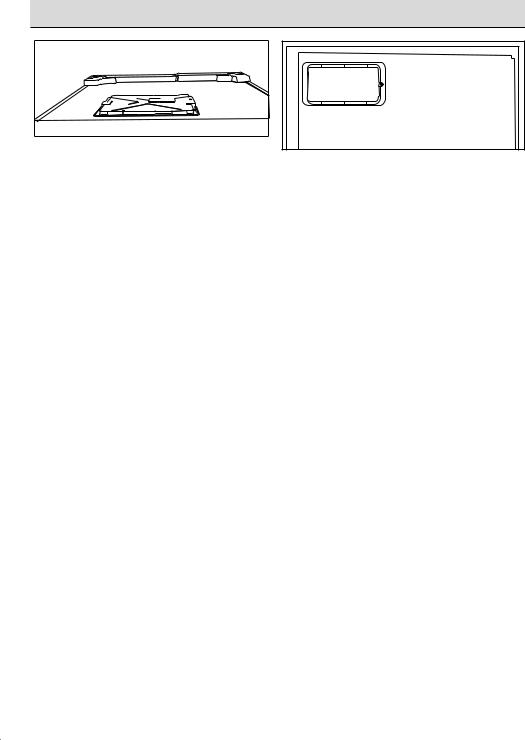
Safety and environment instructions
1 |
1 |
•Do not use steam or steamed cleaning materials for cleaning the refrigerator and melting the ice inside. Steam may contact the electrified areas and cause short circuit or electric shock!
•Do not wash the product by spraying or pouring water on it! Danger of electric shock!
•In case of malfunction, do not use the product, as it may cause electric shock. Contact the authorized service before doing anything.
•Plug the product into an earthed socket. Earthing must be done by a qualified electrician.
•If the product has LED type lighting, contact the authorized service for replacing or in case of any problem.
•Do not touch frozen food with wet hands! It may adhere to your hands!
•Do not place liquids in bottles and cans into the freezer compartment. They may burst out!
•Place liquids in upright position after tightly closing the lid.
•Do not spray flammable substances near the product, as it may burn or explode.
Refrigerator/User Manual |
5 / 24 EN |
|
|
|
|

Safety and environment instructions
•Do not keep flammable materials and products with flammable gas (sprays, etc.) in the refrigerator.
•Do not place containers holding liquids on top of the product. Splashing water on an electrified part may cause electric shock and risk of fire.
•Exposing the product to rain, snow, sunlight and wind will cause electrical danger. When relocating the product, do not pull by holding the door handle. The handle may come off.
•Take care to avoid trapping any part of your hands or body in any of the moving parts inside the product.
•Do not step or lean on the door, drawers and similar parts of the refrigerator. This will cause the product to fall down and cause damage to the parts.
•Take care not to trap the power cable.
1.1.1 HC warning
If the product comprises a cooling system using R600a gas, take care to avoid damaging the cooling system and its pipe while using and moving the product. This gas
is flammable. If the cooling system is damaged, keep the product away from sources of fire and ventilate the room immediately.
C The label on the inner left side indicates the type of gas used in the product.
|
6 / 24 EN |
Refrigerator/User Manual |
|
|
|

Safety and environment instructions
1.1.2 For models with water fountain
•In order for the water system inside the refrigerator to operate properly, pressure in the water mains must be between 1-8 bars. A pressure regulator must be used if the pressure in the water mains
is higher than 5 bars. If the pressure in the mains is higher than 8 bars, the refrigerator must not be connected to the mains. If you are not sure about how to measure the water pressure, ask for professional help.
•Use drinking water only.
1.2. Intended use
•This product is designed for home use. It is not intended for commercial use.
•The product should be used to store food and beverages only.
•Do not keep sensitive products requiring controlled temperatures (vaccines, heat sensitive medication, medical supplies, etc.) in the refrigerator.
•The manufacturer assumes no responsibility for any damage due to misuse or mishandling.
•The product’s bench life is 10 years. The spare parts necessary for the product to function will be available for this period.
1.3. Child safety
•Keep packaging materials out of children’s reach.
•Do not allow the children to play with the product.
•If the product’s door comprises a lock, keep the key out of children’s reach.
Refrigerator/User Manual |
7 / 24 EN |
|
|
|
|

Safety and environment instructions
1.4. Compliance with WEEE Directive and Disposing of the Waste Product
This product complies with EU WEEE Directive (2012/19/EU). This product bears a classification symbol for waste electrical and electronic equipment (WEEE).
This product has been manufactured with high quality parts and
materials which can be reused and are suitable for recycling. Do not dispose of the waste product with normal domestic and other wastes at
the end of its service life. Take it to the collection center for the recycling of electrical and electronic equipment. Please consult your local authorities to learn about these collection centers.
1.5. Compliance with RoHS Directive
• This product complies with EU WEEE Directive (2011/65/EU). It does not contain harmful and prohibited materials specified in the Directive.
1.6. Package information
•Packaging materials of the product are manufactured from recyclable materials in accordance with our National Environment Regulations. Do not dispose of the packaging materials together with the domestic or other wastes. Take them to the packaging material collection points designated by the local authorities.
|
8 / 24 EN |
Refrigerator/User Manual |
|
|
|

2 Your refrigerator




 1
1
12 |
* |
|
2*
*3 

 4
4

5
|
6 |
11 |
* |
|
* |
10
7
|
9 |
|
|
|
8 |
|
|
1. |
Indicator panel |
7. |
Bottle shelves |
2. |
Butter & Cheese sections |
8. |
Adjustable front feet |
3. |
Water dispenser filling tank |
9. |
Chiller |
4. |
Egg section |
10.Chiller cover and glass |
|
5. |
Water dispenser reservoir |
11.Movable shelves |
|
6. |
Adjustable door shelves |
12.Wine cellar |
|
*OPTIONAL
Figures that take place in this instruction manual are schematic and C may not correspond exactly with your product. If the subject parts are
not included in the product you have purchased, then it is valid for other models.
Refrigerator/User Manual |
9 / 24 EN |
|
|
|
|
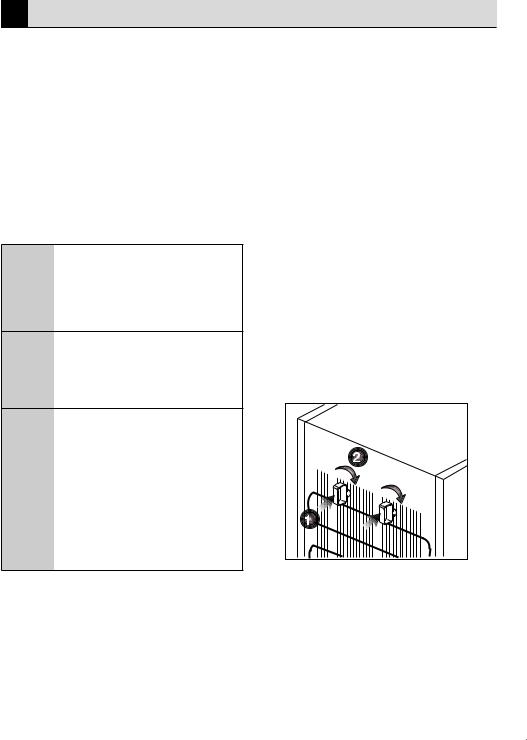
3 Installation
Appropriate installation location
Contact an Authorized Service for the installation of the product. In order to prepare the product for use, refer the information in the user manual and ensure that electrical installation and water installation are appropriate. If not, call a qualified electrician and technician to have any necessary arrangements carried out.
WARNING: Manufacturer shall Bnot be held liable for damages
that may arise from procedures carried out by unauthorized persons.
WARNING: Product must Bnot be plugged in during
installation. Otherwise, there is the risk of death or serious injury!
WARNING:
If the door clearance of the room where the product shall be place is so tight to prevent
Apassing of the product, remove the door of the room and pass the product through the door by turning it to its side; if this does not work, contact the authorized service.
•Placetheproductonanevenfloor surface to prevent jolts.
•Installtheproductatleast30cm away from heat sources such as hobs, heater cores and stoves and at least 5 cm away from electrical ovens.
•Productmustnotbesubjectedto direct sun light and kept in humid places.
•Appropriateairventilationmustbe provided around your product in order to achieve an efficient operation. If the product is to be placed in a recess in the wall, pay attention to leave at least 5 cm distance with the ceiling and side walls.
Installing the plastic wedges
Plastic wedges supplied with the product are used to create the distance for the air circulation between the product and the rear wall.
1.To install the wedges, remove the screws on the product and use the screws supplied together with the wedges.
2.Insert the 2 plastic wedges onto the rear ventilation cover as illustrated in the figure.
|
10 / 24 EN |
Refrigerator/User Manual |
|
|
|

Installation
Adjusting the feet
If the product stands unbalanced after installation, adjust the feet on the front by rotating them to the right or left.
Electrical connection
A WARNING: Do not make connections via extension cables or multi-plugs.
WARNING: Damaged
B power cable must be replaced by the Authorized Service Agent.
If two coolers are to be
Cdistance between them.
•Our company shall not be liable for any damages that will arise when the product is used without
grounding and electrical connection in accordance with the national regulations.
•Power cable plug must be within easy reach after installation.
•Connect your refrigerator to a grounded outlet rated for a voltage value of 220-240V /50 Hz. Outlet shall have 10 to 16A fuse.
•Do not extension cords or cordless multiple outlets between your product and the wall outlet.installed side by side, thereshould be at least 4 cm
Changing the illumination lamp
To change the Bulb/LED used for illumination of your refrigerator, call your Authorized Service.
The lamp(s) used in this appliance is not suitable for household room illumination. The intended purpose of this lamp is to assist the user to place foodstuffs in the refrigerator/freezer in a safe and comfortable way.
Door Open Warning
(This feature is optional)
An audio warning signal will be given when the door of your product is left open for at least 1 minute. This warning will be muted when the door is closed or any of the display buttons (if any) are pressed.
Refrigerator/User Manual |
11 / 24 EN |
|
|
|
|
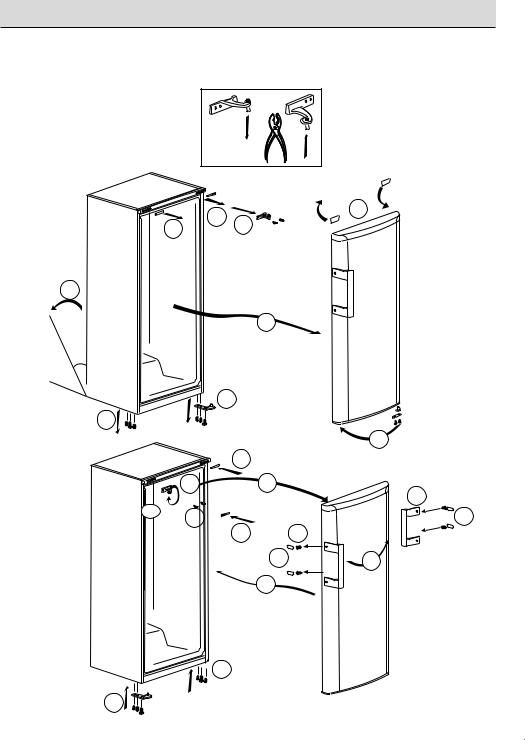
Installation
(12)
|
2 |
5 |
|
1 |
3 |
||
|
6
4
45¡
|
8 |
|
|
7 |
|
|
|
|
|
|
9 |
|
16 |
|
|
|
12 |
13 |
20 |
180¡ |
|
|
|
15 |
|
21 |
|
|
16 |
|
18 |
|
|
17 |
19 |
|
|
14 |
|
11
10
|
12 / 24 EN |
Refrigerator/User Manual |
|
|
|

4Preparation
•Your refrigerator should be installed at least 30 cm away from heat sources such as hobs, ovens, central heater and stoves and at least 5 cm away from electrical ovens and should not be located under direct sunlight.
•The ambient temperature of the room where you install your refrigerator should at least be 5°C. Operating your refrigerator under cooler conditions is not recommended with regard to its efficiency.
•Please make sure that the interior of your refrigerator is cleaned thoroughly.
•If two refrigerators are to be installed side by side, there should be at least 2 cm distance between them.
•When you operate your refrigerator for the first time, please observe the following instructions during the initial six hours.
•The door should not be opened frequently.
•It must be operated empty without any food in it.
•Do not unplug your refrigerator. If a power failure occurs out of your control, please see the warnings in
the “Recommended solutions for the problems” section.
•Original packaging and foam materials should be kept for future transportations or moving.
•The baskets/drawers that are provided with the chill compartment must always be in use for low energy consumption and for better storage conditions.
•Food contact with the temperature sensor in the freezer compartment may increase energy consumption of the appliance. Thus any contact with the sensor(s) must be avoided.
•In some models, the instrument panel automatically turns off 5 minutes after the door has closed. It will be reactivated when the door has opened or pressed on any key.
•Due to temperature change as a result of opening/closing the product door during operation, condensation on the door/body shelves and the glass containers is normal
Refrigerator/User Manual |
13 / 24 EN |
|
|
|
|

5 Using your freezer
The operating temperature is regulated by the temperature control.
Warm |
|
|
|
Cold |
1 |
2 |
3 |
4 |
5 |
(Or) Min. |
|
|
|
Max. |
0=System cooling is off.
1=Lowest cooling setting (Warmest setting).
5=Highest cooling setting (Coldest setting).
The average temperature inside the fridge should be around +5°C.
Please choose the setting according to the desired temperature.
Please note that there will be different temperatures in the cooling area.
The coldest region is immediately above the vegetable compartment.
The interior temperature also depends on ambient temperature, the frequency with which the door is opened and the amount of foods kept inside.
Frequently opening the door causes the interior temperature to rise.
For this reason, it is recommended to close the door again as soon as possible after use.
The interior temperature of your refrigerator changes for the following reasons;
•Seasonaltemperatures,
•Frequentopeningofthedoorand leaving the door open for long periods,
•Foodputintotherefrigeratorwithout cooling down to the room temperature,
•Thelocationoftherefrigeratorinthe room (e.g. exposing to sunlight).
•Youmayadjustthevaryinginterior temperature due to such reasons by using the thermostat. Numbers around the thermostat button indicates the cooling degrees.
•Iftheambienttemperatureishigher than 32°C, turn the thermostat button to maximum position.
•Iftheambienttemperatureislower than 25°C, turn the thermostat button to minimum position.
Figures in this user manual are schematic and may not match the product C exactly. If the subject parts are not included in the product you have
purchased, then those parts are valid for other models.
|
14 / 24 EN |
Refrigerator/User Manual |
|
|
|

Operating the product
Cooling |
|
Defrosting of the appliance |
Food storage |
|
The appliance defrosts automatically. |
The fridge compartment is for the short- |
||
term storage of fresh food and drinks. |
||
Store milk products in the intended |
||
compartment in the cooler/freezer. |
||
Bottles can be stored in the bottle |
||
holder or in the bottle shelf of the door. |
||
Raw meat is best kept in a polyethylene |
||
bag in the compartment at the very |
||
bottom of the cooler/freezer. |
||
Allow hot foods and beverages to cool |
||
to room temperature prior to placing |
||
them in the cooler/freezer. |
||
•Attention |
|
|
Store concentrated alcohol only |
||
standing upright and tightly closed. |
||
•Attention |
|
|
Do not store explosive substances or |
||
containers with |
flammable propellant |
|
gases (canned cream, spray cans etc.) in |
||
the device. There is a danger of explosion. |
||
Placing the food |
||
|
|
|
Egg tray |
Egg |
|
|
|
|
Fridge |
Food in pans, |
|
covered plates |
|
|
compartment |
|
|
and closed |
|
|
shelves |
|
|
containers |
|
|
|
|
|
|
Small and |
|
Fridge |
packaged food or |
|
compartment |
drinks (such as |
|
door shelves |
milk, fruit juice |
|
|
and beer) |
|
Crisper |
Vegetables and |
|
fruits |
|
|
|
|
|
Refrigerator/User Manual |
15 / 24 EN |
|
|
|
|

Operating the product
Using the water dispenser
*optional
C It is normal for the first few glasses of water taken from the dispenser to be warm.
C If the water dispenser is not used for a long period of time, dispose of first few glasses of water to obtain
fresh water.
1. Push in the lever of the water dispenser with your glass. If you are using a soft plastic cup, pushing the lever with your hand will be easier.
2. After filling the cup up to the level you want, release the lever.
C
|
16 / 24 EN |
Refrigerator/User Manual |
|
|
|

Operating the product
Filling the water dispenser's tank
Water tank filling reservoir is located inside the door rack.
1. Open the cover of the tank.
2. Fill the tank with fresh drinking water.
3. Close the cover.
C Do not fill the water tank with any other liquid except for water such as fruit juices, carbonated beverages or alcoholic drinks which are not suitable to use in the water dispenser. Water dispenser will be irreparably damaged if these kinds of liquids are used. Warranty does not cover such usages. Some chemical substances and additives contained in these kinds of drinks/liquids may damage the water tank.
C Use clean drinking water only.
Refrigerator/User Manual |
17 / 24 EN |
|
|
|
|
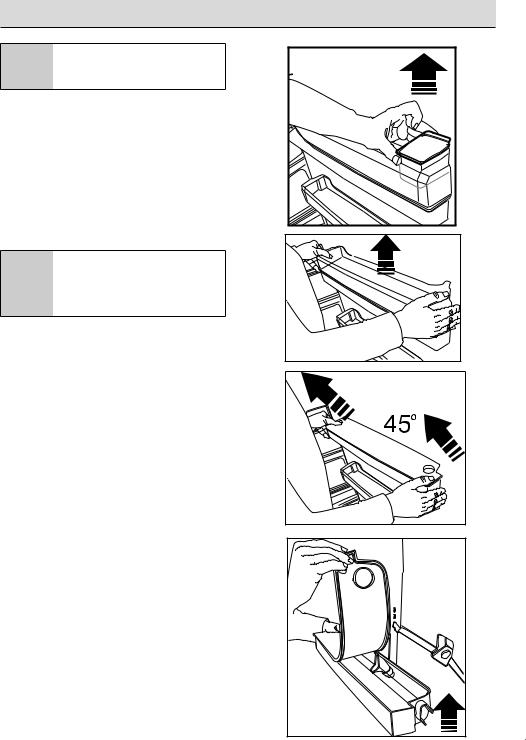
Operating the product
C Capacity of the water tank is 3 litres; do not overfill.
Cleaning the water tank
1. Remove the water filling reservoir inside the door rack.
2. Remove the door rack by holding from both sides.
3. Grab the water tank from both sides and remove it with an angle of 45°C.
4. Remove the cover of the water tank and clean the tank.
C Components of the water tank and water dispenser should not be washed in dishwasher.
|
18 / 24 EN |
Refrigerator/User Manual |
|
|
|
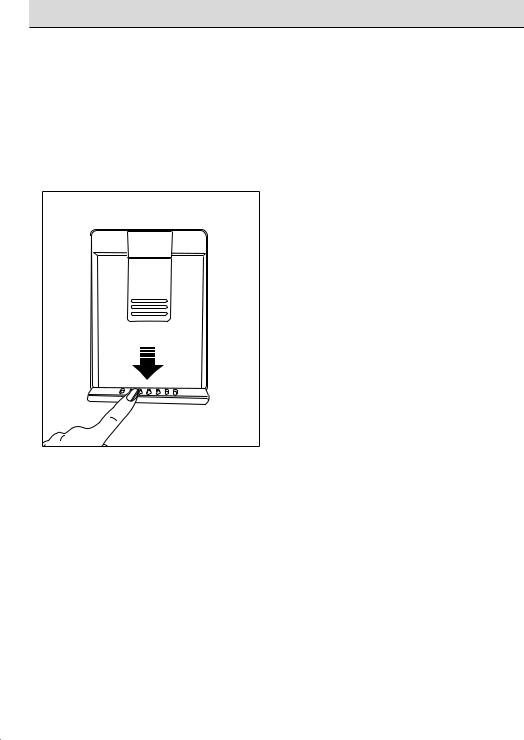
Operating the product
Drip tray
Water that dripped while using the water dispenser accumulates in the spillage tray.
Remove the plastic filter as shown in the figure.
With a clean and dry cloth, remove the water that has accumulated.
Refrigerator/User Manual |
19 / 24 EN |
|
|
|
|

6 Maintenance and cleaning
Cleaning your fridge at regular intervals will extend the service life of the
product.
B
•Never use gasoline, benzene or similar substances for cleaning purposes.
•Never use any sharp and abrasive tools, soap, household cleaners, detergent and wax polish for cleaning.
•Dissolve one teaspoon of bicarbonate in half litre of water. Soak a cloth with the solution and wrung it thoroughly. Wipe the interior of the refrigerator with this cloth and the dry thoroughly.
•Make sure that no water enters the lamp housing and other electrical items.
•If you will not use the refrigerator for a long period of time, unplug it, remove all food inside, clean it and leave the door ajar.
•Check regularly that the door gaskets are clean. If not, clean them.
•To remove door and body shelves, remove all of its contents.
•Remove the door shelves by pulling them up. After cleaning, slide them from top to bottom to install.
•Never use cleaning agents or water that contain chlorine to clean the outer surfaces and chromium coated parts of the product. Chlorine causes corrosion on such metal surfaces.
6.1. Avoiding bad odours
Materials that may cause odour are not used in the production of our refrigerators. However, due to
inappropriate food preserving conditions and not cleaning the inner surface of the refrigerator as required can bring forth the problem of odour. Pay attention to following to avoid this problem:
•Keeping the refrigerator clean is important. Food residuals, stains, etc. can cause odour. Therefore, clean the refrigerator with bi-carbonate dissolved in water every few months. Never use detergents or soap.
•Keep the food in closed containers. Microorganisms spreading out from uncovered containers can cause unpleasant odours.
•Never keep the food that have passed best before dates and spoiled in the refrigerator.
6.2. Protecting the plastic surfaces
Do not put liquid oils or oil-cooked meals in your refrigerator in unsealed containers as they damage the plastic surfaces of the refrigerator. If oil is spilled or smeared onto the plastic surfaces, clean and rinse the relevant part of the surface at once with warm water.
|
20 / 24 EN |
Refrigerator/User Manual |
|
|
|

7 Troubleshooting
Check this list before contacting the service. Doing so will save you time and money. This list includes frequent complaints that are not related to faulty workmanship or materials. Certain features mentioned herein may not apply to your product.
The refrigerator is not working.
•The power plug is not fully settled. >>> Plug it in to settle completely into the socket.
•The fuse connected to the socket powering the product or the main fuse is blown. >>> Check the fuses.
Condensation on the side wall of the cooler compartment (MULTI ZONE, COOL, CONTROL and FLEXI ZONE).
•The door is opened too frequently >>> Take care not to open the product’s door too frequently.
•The environment is too humid. >>> Do not install the product in humid environments.
•Foods containing liquids are kept in unsealed holders. >>> Keep the foods containing liquids in sealed holders.
•The product’s door is left open. >>> Do not keep the product’s door open for long periods.
•The thermostat is set to too low temperature. >>> Set the thermostat to appropriate temperature.
Compressor is not working.
•In case of sudden power failure or pulling the power plug off and putting back on, the gas pressure in the product’s cooling system is not balanced, which triggers the compressor thermic safeguard. The product will restart after approximately 6 minutes. If the product does not restart after this period, contact the service.
•Defrosting is active. >>> This is normal for a fully-automatic defrosting product. The defrosting is carried out periodically.
•The product is not plugged in. >>> Make sure the power cord is plugged in.
•The temperature setting is incorrect. >>> Select the appropriate temperature setting.
•The power is out. >>> The product will continue to operate normally once the power is restored.
The refrigerator's operating noise is increasing while in use.
•The product’s operating performance may vary depending on the ambient temperature variations. This is normal and not a malfunction.
Refrigerator/User Manual |
21 / 24 EN |
|
|
|
|

Troubleshooting
The refrigerator runs too often or for too long.
•The new product may be larger than the previous one. Larger products will run for longer periods.
•The room temperature may be high. >>> The product will normally run for long periods in higher room temperature.
•The product may have been recently plugged in or a new food item is placed inside. >>> The product will take longer to reach the set temperature when recently plugged in or a new food item is placed inside. This is normal
•Large quantities of hot food may have been recently placed into the product.
>>> Do not place hot food into the product.
•The doors were opened frequently or kept open for long periods. >>> The warm air moving inside will cause the product to run longer. Do not open the doors too frequently.
•The freezer or cooler door may be ajar. >>> Check that the doors are fully closed.
•The product may be set to temperature too low. >>> Set the temperature to a higher degree and wait for the product to reach the adjusted temperature.
•The cooler or freezer door washer may be dirty, worn out, broken or not properly settled. >>> Clean or replace the washer. Damaged / torn door washer will cause the product to run for longer periods to preserve the current temperature.
The freezer temperature is very low, but the cooler temperature is adequate.
•The freezer compartment temperature is set to a very low degree. >>> Set the freezer compartment temperature to a higher degree and check again.
The cooler temperature is very low, but the freezer temperature is adequate.
•The cooler compartment temperature is set to a very low degree. >>> Set the freezer compartment temperature to a higher degree and check again.
The food items kept in cooler compartment drawers are frozen.
•The cooler compartment temperature is set to a very low degree. >>> Set the freezer compartment temperature to a higher degree and check again.
|
22 / 24 EN |
Refrigerator/User Manual |
|
|
|

Troubleshooting
The temperature in the cooler or the freezer is too high.
•The cooler compartment temperature is set to a very high degree. >>> Cooler compartment temperature setting has an effect on the freezer compartment temperature. Change the temperature of the cooler or freezer compartment and wait until the temperature of the related compartments come to the adequate level.
•The doors were opened frequently or kept open for long periods. >>> Do not open the doors too frequently.
•The door may be ajar. >>> Fully close the door.
•The product may have been recently plugged in or a new food item is placed inside. >>> This is normal. The product will take longer to reach the set temperature when recently plugged in or a new food item is placed inside.
•Large quantities of hot food may have been recently placed into the product.
>>> Do not place hot food into the product.
Shaking or noise.
•The ground is not level or durable. >>> If the product is shaking when moved slowly, adjust the stands to balance the product. Also make sure the ground is sufficiently durable to bear the product.
•Any items placed on the product may cause noise. >>> Remove any items placed on the product.
The product is making noise of liquid flowing, spraying etc.
•The product’s operating principles involve liquid and gas flows. >>> This is normal and not a malfunction.
There is sound of wind blowing coming from the product.
•The product uses a fan for the cooling process. This is normal and not a malfunction.
There is condensation on the product's internal walls.
•Hot or humid weather will increase icing and condensation. This is normal and not a malfunction.
•The doors were opened frequently or kept open for long periods. >>> Do not open the doors too frequently; if open, close the door.
•The door may be ajar. >>> Fully close the door.
There is condensation on the product's exterior or between the doors.
•The ambient weather may be humid, this is quite normal in humid weather. >>>
The condensation will dissipate when the humidity is reduced.
Refrigerator/User Manual |
23 / 24 EN |
|
|
|
|
